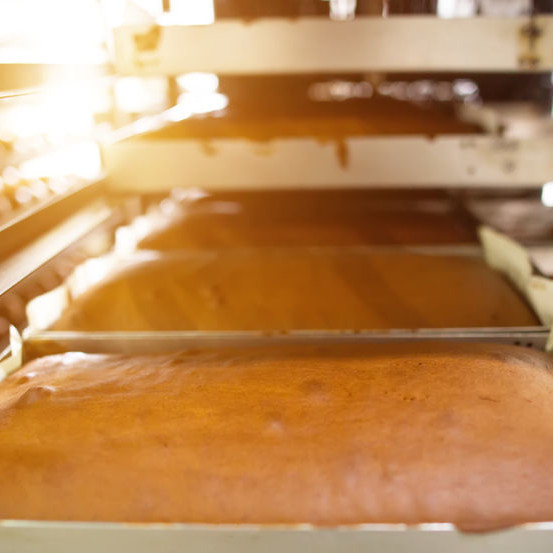
Leavening Acids
Also known as baking acids
What are Leavening Acids?
Leavening acids are a group of organic and inorganic acids which form a component of chemical leavening systems. Chemical leaveners are used to provide volume and characteristic crumb structure in batter cakes and other sweet baked goods.
Different leavening acids are available to bakers:
- Organic acids: tartaric, fumaric, cream of tartar, glucono delta lactone
- Inorganic acids: SAPP, SALP, MCP, SAS, DMP
Origin
In the early 1800s the development of chemical leavening agents for the bakery market started with the introduction of sodium bicarbonate.
Primitive baking acids included tartaric acid and cream of tartar from the winemaking industry. Several decades later, in the late 1800s and early 1900s, acid phosphate and food phosphates were developed and successfully introduced to the baking industry. The first commercially produced baked sweet goods contained baking soda and acidic ingredients (e.g. sour milk and citric juices). This system created the proper conditions for “unplanned” chemical leavening in cakes.
Function
In conjunction with a food-grade base such as baking soda, leavening acids produce carbon dioxide that provides the leavening or expansion effect in baked products. This mixture is commonly known as baking powders which often include a carrier or vehicle, such as starch.
Baking acids participate in the neutralization reactions with bases (sodium bicarbonate, potassium bicarbonate, ammonium bicarbonate):1
Base + Leavening Acid → Neutral Salt + Water + CO2
The optimum acid (or combination of acids) is the one that produces a final product with the intended characteristics such as volume, crumb structure, crust color, etc.
Commercial production
Leavening acids come from natural sources as well as industrial synthesis. Inorganic leavening acids are produced from controlled chemical reactions to produce food-grade compounds. These are properly diluted and mixed with dry vehicles like starches.
Application
Considerations when formulating leavening acids:2
- Neutralizing value (NV) is the amount of base needed to react with 100 parts of acid by weight
- Chemical composition and compliance with clean label initiatives (calcium-, sodium-, magnesium- and aluminum-containing compounds)
- Rate of reaction (ROR) or timing of gas release, such as slow-acting, fast-acting, double-acting. ROR depends on acid and base dissolving and reacting in the batter or dough.
- Cost per Kg (lb)
- USP Food Chemical Codex status and food safety regulations
- Refrigerated, frozen or ambient storage conditions
Typical characteristics of leavening acids2
Organic
| Chemical name | Abbreviation | Chemical formula | Neutralizing value (NV) | Rate of Reaction (ROR) |
| Fumaric acid | N/A | C4H4O4 | 145 | Very fast |
| Tartaric acid | N/A | C4H6O6 | 116 | Very fast |
| Cream of tartar | N/A | C4H5KO6 | 45 | Fast |
| Glucono delta lactone | GDL | C6H10O6 | 45 | Delayed / slow |
Inorganic
| Chemical name | Abbreviation | Chemical formula | Neutralizing value (NV) | Rate of Reaction (ROR) |
| Sodium aluminum phosphate | SALP | NaH14Al3(PO4)8·4H2O | 100 | Very slow |
| Sodium aluminum sulfate | SAS | Al2(SO4)3·Na2SO4 | 104 | Very slow |
| Dimagnesium phosphate | DMP | MgHPO4·3H2O | 40 | Reacts only with heating |
| Dicalcium phosphate | DCPD | CaHPO4·2H2O | 33 | Reacts only with heating |
| Monocalcium phosphate | MCP | Ca(H2PO4)2·H2O | 80 | Fairly fast |
| Sodium acid pyrophosphate | SAPP | Na2H2P2O7 | 72 | Slow |
- Acid type: moisture and/or heat reactivity depend greatly on solubility and dissociation extent
- Particle size of acid/base powder
- Batter or dough temperature
- Amount of leavening acid and base: the acids can be used alone or in combination in stoichiometric amounts relative to the amount of CO2 to be released
- Water activity (hydration)
- Presence of water-binding ingredients (e.g. sugars, alcohols, starches, gums, salt)
- Presence of cations (calcium)
FDA regulation
According to 21 CFR Part 182, leavening acids are GRAS Food Substances.3
References
- Delcour, J.A. “Chemically Leavened Products.” Principles of Cereal Science and Technology, 3rd edition, AACC International, Inc., 2010, pp. 177–181.
- Köksel, H., and Gökmen, V. “Chemical Reactions in the Processing of Soft Wheat Products.” Food Engineering Aspects of Baking Sweet Goods, CRC Press, Taylor & Francis Group, LLC, 2008, pp. 49–80.
- U.S. Food and Drug Administration, CFR – Code of Federal Regulations Title 21, https://www.accessdata.fda.gov/scripts/cdrh/cfdocs/cfcfr/CFRSearch.cfm?CFRPart=182&showFR=1, Accessed 17 May 2020.

